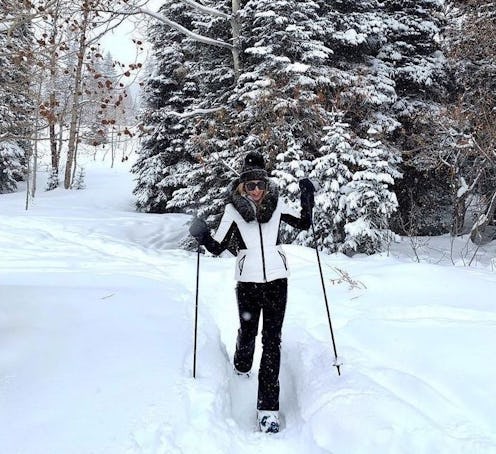(The Shopping List)
7 Cold-Weather Essentials I Swear By For An Outdoor Adventure
My stylish checklist of functional pieces to enjoy a chilly Mother Nature.

Outdoor winter adventures haven’t quite been my comfort zone for most of my life. Growing up between California and Arizona, snow was pretty much a novelty apart from the occasional jaunt to the mountains or visiting family in the midwest. I was usually grumpy, if not tear-filled, during these times — let’s just say ski school was not my jam at age five. However, moving to New York City in 2010 quickly forced an adjustment to chiller temperatures, and a new wardrobe of cold-weather essentials to match. Since then, I’ve managed to take up outside activities from skiing to winter running — the occasional snowshoeing excursion, too! I genuinely enjoy a brisk jog in the cold and ski trips to the mountains for more than the après pursuits. And now, since relocating to Colorado this year, I’m all-in for upping my outdoorsy game, from cold-weather hiking to advancing my running and ski skills.
Since dipping my toe in the winter activity pool, I’ve learned the importance of gear designed for the elements. Things like moisture-wicking wool and heat-tech lining are two highly functional fabrics for staying warm while spiking your heart rate in the cold. The same goes for proper footwear, like insulated and slip-resistant boots and sneakers. And equally critical are socks — a less-than-sexy but incredibly essential piece of the cold-weather puzzle for staying dry and comfortable during chilly ventures.
Layering is, of course, key, too. But a quick lesson I learned: Don’t overdo it. Though those initial few freezing minutes might make you want to turn around and retreat to the cozy indoors, the moment you get going, things heat up fast. Two layers usually do it for me — a long-sleeve base and adjustable topper. Plus, accessories to protect vulnerable spots like your neck, hands, ankles, and head. Until you’ve set out for a brisk outdoor escapade, said points are easy to overlook, and you invariably learn the hard way (like me). Another realization I came to after a handful of outings is the mobility I need to perform at my best. If you’re swaddled too tightly or garbed in overly hefty layers, you’ll likely tire faster and feel prohibited from a full range of motion. Not my ideal state when I’m looking to break a sweat or challenge myself with new experiences. Instead, lightweight yet well-insulated pieces are the ticket for optimal mobility.
Without further ado, my shopping list of cold-weather essentials, ahead. Some tend to be more gear-y than others, yes. But, ultimately, these pieces are tried-and-tested favorites for various activities and levels of cold.
We only include products that have been independently selected by TZR’s editorial team. However, we may receive a portion of sales if you purchase a product through a link in this article.
A Puffer Jacket
Like the five-plus pairs of black ankle boots I own (they’re all different!), the many puffer coats in my closet all serve various purposes. Lightweight, packable styles are great as a top layer in moderately chilly weather for hiking or a run, usually with a long sleeve tee as my base. But for snowier adventures, like skiing or snowshoeing, heavy styles are a must. Often, I’ll select one of my ski jackets or, if it’s super cold, I’ll add a packable style as a mid-layer for extra warmth — they’re easy to peel on and off as needed.
Warm Pants
I have tons of workout leggings, but most don’t cut it in the cold. So instead, I turn to lined and insulated styles designed to perform in inclement weather like rain, snow, or ice. Joggers, leggings, quilted trousers, and snow pants are my go-to’s.
Long-Sleeve Tee
After my first few cold-weather runs and inaugural snowshoeing excursion, I quickly learned how few layers I actually needed. A long-sleeve tee that’s lightweight and moisture-wicking to regulate my core temperature is the hero piece that grounds every one of my active winter outfits. My favorites include thermal or seamless crewnecks and breathable turtlenecks, usually in soft, whisper-thin fabrics.
A Vest
It took me a while to come around to the vest — for the longest time, it felt like the ultimate granola style symbol. Now, I realize that puffy and fleece iterations are ideal in brisk but not freezing weather, usually layered over a heavier weight long sleeve. I’ll also sport them as a mid-layer under a warmer puffer for extra-cold days in the snow.
Weather-Proof Shoes
Almost nothing is as excruciating as freezing feet. Okay, one thing, wet and freezing feet, which is why weather-proof shoes are a must-have. Like puffers, I require a few different styles for various activities. A weatherized sneaker for runs or leisurely trail walks keeps me feeling secure on slick grounds while offering plenty of breathability. A sturdy waterproof hiking boot with grippy soles and insulation is the key to comfortable cold-weather hikes. And for snowshoeing, I’m all about a cozy puffer boot — an inadvertent realization I came to on a ski trip where I only packed shoes for snowy walks to and from the mountain. So comfy.
Socks
Almost more important than an element-proof shoe is a pair of warm socks made to perform. From crew socks for running to knee-high cuts made for boots, wool and moisture-wicking styles are the best for breathability and insulation.
Accessories
You don’t quite understand the importance of cold-weather accessories until you’ve felt the excruciating sensation of numbing extremities. Exposed areas like your neck and ankles will quickly bring down your body temperature, too. Down mittens and a hat are the real MVPs for me, along with warm socks and a turtleneck as my base. Sports sunglasses and a waterproof bag are crucial extras for me, too, for activities in the sun or when you need to tote other essentials.
This article was originally published on